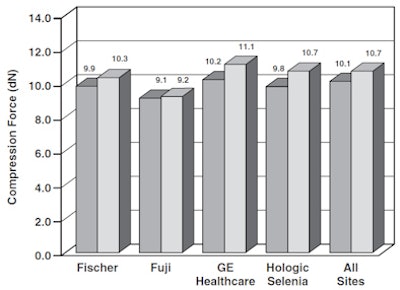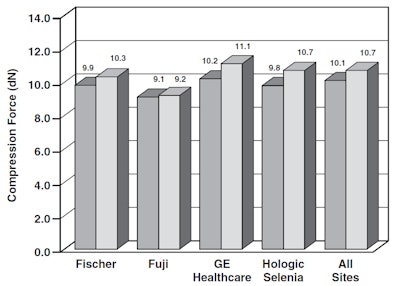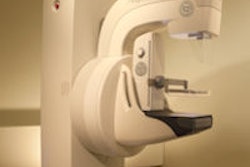
Although the differences between full-field digital mammography (FFDM) and film-screen mammography (FSM) in terms of compression force are small, FFDM delivers much less radiation than analog mammography, according to a study to be published in the February issue of the American Journal of Roentgenology.
Lead researcher Edward Hendrick, Ph.D., of the University of Colorado at Denver and colleagues found that FFDM had a 22% lower mean glandular radiation dose than film-screen mammography per acquired view. The team also found significant variations in FFDM radiation doses by manufacturer (AJR, February 2010, Volume 194:2, pp. 362-369).
Hendrick and colleagues used data from the American College of Radiology Imaging Network (ACRIN) Digital Mammographic Imaging Screening Trial (DMIST).
For DMIST, digital mammography was performed with five systems from four manufacturers:
- SenoScan (Fischer Imaging, Denver; no longer commercially available)
- FCRm (Fujifilm Medical Systems USA, Stamford, CT)
- Senographe 2000D (GE Healthcare, Chalfont St. Giles, U.K.)
- Selenia (Hologic, Bedford, MA)
- Lorad/Trex Digital Mammography System (subsequently replaced by Selenia)
Hendrick's team evaluated technical data from 5,102 DMIST participants at 33 sites, and found that the mean dose from a single digital mammography view was significantly lower than that received by the same women imaged with film-screen mammography: 1.86 mGy average breast radiation dose per view for digital as compared to 2.37 mGy for film-screen.
"The primary reason for lower doses per view with FFDM [in DMIST], especially for thicker breasts, was that for the same breast thickness, FFDM systems selected a harder x-ray beam than [film-screen] mammography," Hendrick and colleagues wrote. "The use of a harder beam for FFDM takes advantage of fundamental detector differences between most FFDM systems and [film-screen] mammography."
Of the film-screen mammography cases, 12% required more than the normal four views, while 21% of the FFDM cases required more than the four normal views; when extra views were included, mean glandular dose per subject was 4.15 mGy for FFDM and 4.98 mGy for film-screen, 17% lower for FFDM than film-screen.
When the team compared each FFDM unit's compression force to film-screen mammography, it found that the differences between the two modalities were small. Mean compressed breast thickness over all units and sites was 5.3 cm for film-screen mammography and 5.4 cm for FFDM, a 1.7% difference.
 |
| Comparison of breast compression force between digital (darker gray) and film-screen (lighter gray) mammography by digital manufacturer, averaged over all views, subjects, and sites. Image courtesy of the American Roentgen Ray Society. |
All FFDM units are not created equal
The researchers found dose variations between each FFDM unit, compared to film-screen mammography, as well:
|
The study also compared mean glandular dose per view versus compressed breast thickness (in 1-cm increments) for FSM and FFDM by manufacturer. Results included the following:
- Fuji's computed radiography system showed a reasonable match between mean glandular doses for film-screen mammography and FFDM across the full range of compressed breast thickness.
- Fischer's SenoScan and GE Healthcare's Senographe 2000D showed similar results between FSM and FFDM for thinner breasts, with mean glandular doses for FFDM lower than FSM doses. However, FFDM doses increased -- albeit, more slowly than FSM doses -- as breast thickness increased.
- Hologic's Selenia showed FFDM doses higher than FSM doses over the entire thickness range.
Digital mammography technology has changed since DMIST was conducted, the authors wrote, noting that the study results can serve as a reference point as the technology continues to develop.
"The dose differences among different FFDM manufacturers have, to our knowledge, not been previously published, nor has the effect on dose of extra views that were required by different digital detector sizes," they wrote. "Although there are some differences in the dose performance of new digital systems compared to those used in DMIST, this article provides a reference point at the onset of the adoption of digital mammography to which future doses in digital mammography can be compared."
By Kate Madden Yee
AuntMinnie.com staff writer
January 21, 2010
Related Reading
DMIST data show equivalence between CAD applications, November 9, 2009
DMIST finds variability between FFDM systems, July 27, 2009
DMIST: Women under 50 with dense breasts benefit from FFDM, January 29, 2008
More DMIST analysis supports FFDM in younger women, dense breasts, November 26, 2006
Do DMIST results underestimate FFDM's impact? October 24, 2005
Copyright © 2010 AuntMinnie.com



















